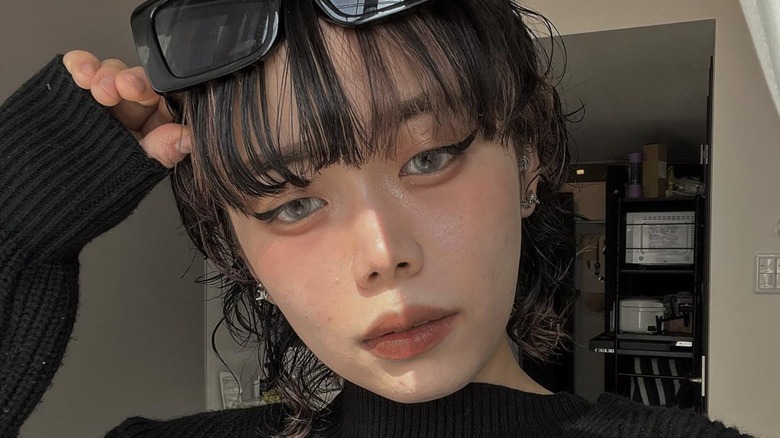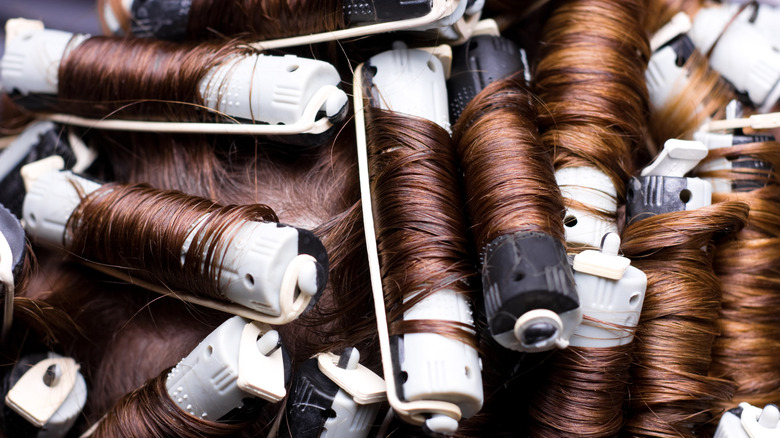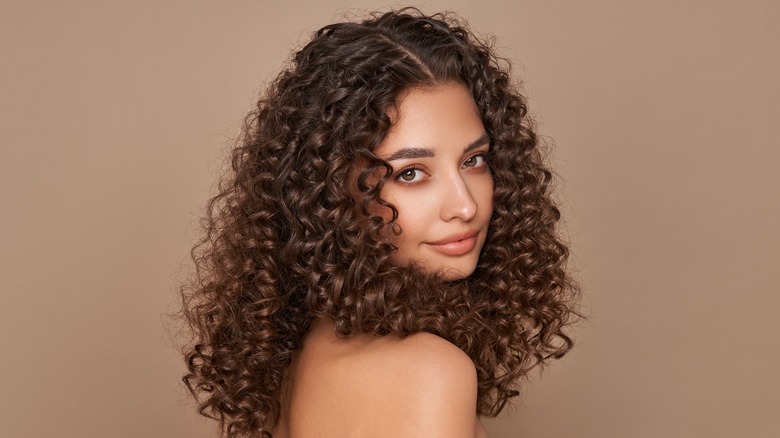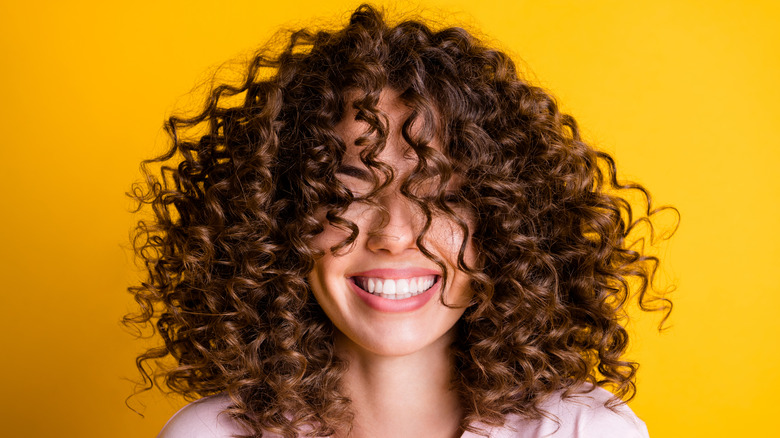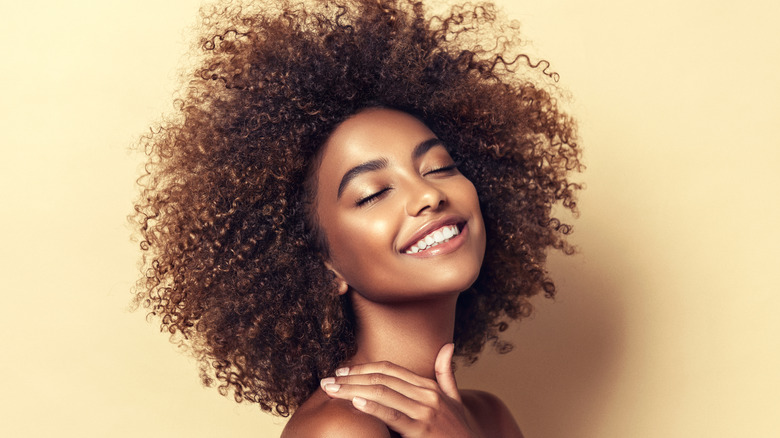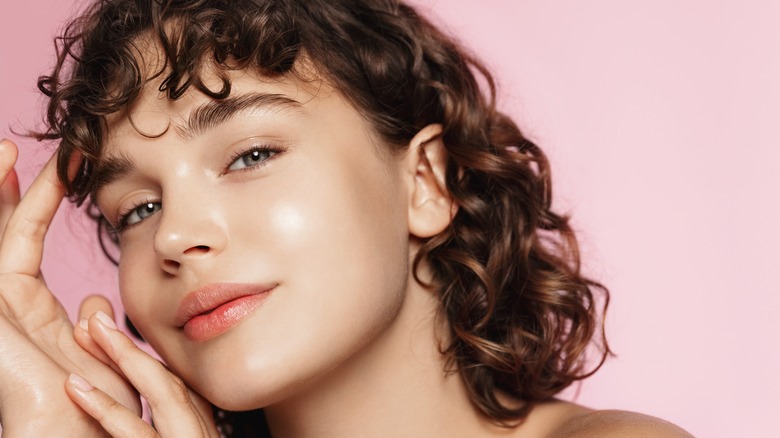How Damaging Are Perms For Your Hair Really?
Perms can be polarizing. People either swear by them to create their signature look or they think of bad hairstyles consisting of frizzy, unruly hair. They can also get a bad rep for being damaging because of the chemical process necessary to create a perm. As the name suggests, the term "permanent hairstyle" has been shortened to "perm." However, a perm isn't forever; they tend to last between three to six months, according to Prose. When your hair grows out, it'll grow in with your natural texture, which means you can get another perm or let the permed ends grow out.
There are one-step and two-step perms, says My Hairdressers. One-step, or single action, perms tend to be used on straighter hair, while two-step, or dual action, are used on African hair. In most perms, regardless of treatment type, ammonium thioglycolate is the active chemical. It's not uncommon to be cautious about the kinds of chemicals you put on your hair, especially when the process can cause irreversible damage. So are perms safe or damaging? Technically, they do damage your hair on a molecular level, but if done right, a perm shouldn't completely ruin your hair.
What do perms do to hair?
To understand what perms do to your hair, you have to understand a little bit of the science behind it. Hair is made from keratin, and keratin molecules are held together by disulfide bonds, explains Philip Kingsley. These are the bonds that help keep the shape of the hair and are affected by a perm. During a perm, the chemicals break down the disulfide bonds. When the neutralizer is added to the hair, new disulfide bonds form, which helps the keratin molecules create the shape of the curl.
While the idea of breaking and reforming bonds may sound terrifying, there's no reason to be afraid of perms. They're not the most damaging process you can do to your hair, and it's actually not as detrimental to your hair as bleach, states Healthline. However, getting a perm can weaken your hair and dry it out. Because of this, you have to be cautious about putting a perm over hair that's already dry or prone to breakage. But if you take care of your hair while you have a perm, the treatment is perfectly safe.
Using perms on highlighted and colored hair
So what if your hair is already highlighted, colored, or bleached? Many stylists will suggest holding off on getting a perm if you have previously bleached or colored your hair. Because all of these are chemical processes, putting one on top of the other can be detrimental to your hair. Perming plus a color or bleaching process can cause breakage or split ends, says Style Craze. You should also be cautious because some perms can lighten or fade colored hair.
However, this doesn't mean you have to choose one or the other. According to Michair, you shouldn't do these processes on the same day, but you can spread your appointments about ten to fifteen days apart. It also tends to be better to perm your hair before you color or highlight it. And washing your hair between perming and coloring it will help the color set in. Of course, when it comes to chemical processes, it's always suggested to consult a professional. Schedule a consultation where a stylist will tell you the best process for your individual hair.
What about dry hair?
In order to avoid further damage, your hair should be in a good, healthy condition before getting a perm. Dry hair may be in too fragile of a state to receive a perm. The process of perms can dry out your hair, so doing this treatment on already dry hair can lead to damage and breakage, says All Things Hair. But don't fret, that doesn't mean you can never get a perm. The key is proper nourishment.
Dry hair may be caused by too much heat styling, the wrong hair products, or product buildup, according to Salon Brazyl. In this case, you can take a month or two to change your hair care habits and get your hair moisturized and in a better condition for a perm. But if you're prone to dry hair, it's important to continue to take care to moisturize your tresses after getting a perm. If you don't, you run the risk of frizzy or brittle curls or hair breakage in the future.
Curly and textured hair
Naturally curly and textured hair often gets dry because the natural oils on the scalp can have trouble reaching the bottom of the hair strand, according to Carol's Daughter. And, of course, using a lot of heat can also further dry out curly and textured hair. So what does that mean for getting a perm? According to Rumbie & Co., perming natural curls is a two-step process. The natural texture is removed before the hair is reshaped into the new curl pattern. But because of the natural dryness, it's important to have a knowledgeable stylist working on textured hair.
Curly and textured are naturally prone to breakage, so it's important to further protect it if you perm this type of hair. You want to ensure you're moisturizing and hydrating your hair to keep it strong. You may also want to avoid other chemical processes to prevent any damage that can compromise your strand. Consider implementing the LOC method, which stands for leave-in conditioner, oil, and cream. A water-based leave-in will hydrate, the oil helps moisturize, and the cream moisturizes and helps lock in the moisture.
How to care for permed hair
Like any kind of treated hair, it's important to maintain permed hair properly, or else you run the risk of dry, brittle, or frizzy curls as well as breakage and damage. It's well-known that you shouldn't wash your hair after getting a perm. It's best to wait at least 48 hours after the treatment before washing your hair so as not to lose the curl. But after that time period, you'll want to focus on giving your hair the proper hydration and moisture.
Use a leave-in conditioner and oil treatment on damp hair, suggests Bella Salon & Spa, and it's also good to focus on moisturizing the ends. In addition, you'll want to avoid using a lot of heat when styling your hair to prevent drying it out. And if you must use heat, use a heat protectant product. When combing or detangling your hair, use a wide-tooth comb with slow, gentle movements. Weekly deep conditioning can also help with maintaining moisturized, bouncy, and healthy curls.
